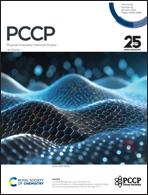Realization of efficient and selective NO and NO2 detection via surface functionalized h-B2S2 monolayer†
Abstract
In the ever-growing field of two-dimensional (2D) materials, the boron–sulfide (B2S2) monolayer is a promising new addition to MoS2-like 2D materials, with the boron (a lighter element) pair (B2 pair) having similar valence electrons to Mo. Herein, we have functionalized the h-phase boron sulfide monolayer by introducing oxygen atoms (Oh-B2S2) to widen its application scope as a gas sensor. The charge carrier mobilities of this system were found to be 790 × 102 cm2 V−1 s−1 and 32 × 102 cm2 V−1 s−1 for electrons and holes, respectively, which are much higher than the mobilities of the MoS2 monolayer. The potential application of the 2D Oh-B2S2 monolayer in the realm of gas sensing was evaluated using a combination of density functional theory (DFT), ab initio molecular dynamics (AIMD), and non-equilibrium Green's function (NEGF) based simulations. Our results imply that the Oh-B2S2 monolayer outperforms graphene and MoS2 in NO and NO2 selective sensing with higher adsorption energies (−0.56 and −0.16 eV) and charge transfer values (0.34 and 0.13e). Furthermore, the current–voltage characteristics show that the Oh-B2S2 monolayer may selectively detect NO and NO2 gases after bias 1.4 V, providing a greater possibility for the development of boron-based gas-sensing devices for future nanoelectronics.

- This article is part of the themed collection: 2024 PCCP HOT Articles


 Please wait while we load your content...
Please wait while we load your content...